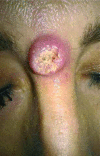Skin cancer in children after organ transplantation
- PMID: 31997989
- PMCID: PMC6986283
- DOI: 10.5114/ada.2019.82680
Skin cancer in children after organ transplantation
Abstract
Skin cancer is the second most common complication of organ transplantation in children. The frequency of skin cancer incidence after organ transplantation is different in paediatric and adult populations. The post-transplant lymphoproliferative disease is the most common group of malignancies after organ transplantation in paediatric population. The majority of researchers who examined children with kidney, liver, heart or lungs grafts observed that the risk of skin cancer was three times higher than in the general population whereas in adults even200 times higher. The occurrence of skin cancer in children after transplantation is extremely rare during childhood. The risk increases in early adulthood. Malignancies occurring after solid organ transplantation result from many different factors. These include the immunological condition of the child, dose and time of immunosuppression, and oncogenic viruses. The increased risk of skin cancer following paediatric transplantation requires prevention and adequate education of children and their parents. These involve avoiding sun exposure and protection such as sunscreens and protective clothing. The early detection of cancer in transplant recipients is very important. Prevention of cancer includes regular dermatological examination.
Keywords: children; immunosuppression; malignant neoplasm; organ transplant recipient.
Copyright © 2019 Termedia.
Conflict of interest statement
The authors declare no conflict of interest.
Figures
Similar articles
-
Skin Cancer Risk Awareness and Sun-Protective Behavior Among Solid-Organ Transplant Recipients.Exp Clin Transplant. 2018 Mar;16 Suppl 1(Suppl 1):203-207. doi: 10.6002/ect.TOND-TDTD2017.P65. Exp Clin Transplant. 2018. PMID: 29528028
-
Skin surveillance of a U.K. paediatric transplant population.Br J Dermatol. 2007 Jan;156(1):45-50. doi: 10.1111/j.1365-2133.2006.07546.x. Br J Dermatol. 2007. PMID: 17199565
-
Post-transplant malignancies in pediatric organ transplant recipients.Pediatr Transplant. 2021 Feb;25(1):e13884. doi: 10.1111/petr.13884. Epub 2020 Oct 27. Pediatr Transplant. 2021. PMID: 33111463 Review.
-
Epithelial malignancies in organ transplant patients: clinical presentation and new methods of treatment.Recent Results Cancer Res. 2002;160:251-8. doi: 10.1007/978-3-642-59410-6_30. Recent Results Cancer Res. 2002. PMID: 12079221
-
Skin cancers following pediatric organ transplantation.Dermatol Surg. 2004 Apr;30(4 Pt 2):616-21. doi: 10.1111/j.1524-4725.2004.30146.x. Dermatol Surg. 2004. PMID: 15061845 Review.
Cited by
-
Targeting Calcineurin Inhibitor-Induced Arterial Hypertension in Liver Transplanted Children Using Hydrochlorothiazide.J Pediatr Pharmacol Ther. 2022;27(5):428-435. doi: 10.5863/1551-6776-27.5.428. Epub 2022 Jul 6. J Pediatr Pharmacol Ther. 2022. PMID: 35845561 Free PMC article.
-
The Aquaporin3 Promoter Polymorphism -1431 A/G is Associated with Acute Graft Rejection and Cytomegalovirus Infection in Kidney Recipients Due to Altered Immune Cell Migration.Cells. 2020 Jun 8;9(6):1421. doi: 10.3390/cells9061421. Cells. 2020. PMID: 32521638 Free PMC article.
References
-
- Bartosh SM, Leverson G, Robillard D, et al. . Long-term outcomes in pediatric renal transplant recipients who survive into adulthood. Transplantation 2003; 76: 1195-203. - PubMed
-
- Webster A, Wong G, McDonald S. Cancer report – Australia and New Zealand Dialysis and Transplant Registry. Available at: http://www.anzdata.org.au/v1/report_2010.html,2010.
-
- Webster AC, Craig JC, Simpson JM, et al. . Identifying high risk groups and quantifying absolute risk of cancer after kidney transplantation: a cohort study of 15183 recipients. Am J Transplant 2007; 7: 2140-51. - PubMed
Publication types
LinkOut - more resources
Full Text Sources


